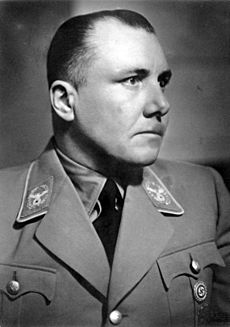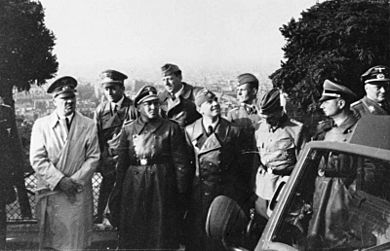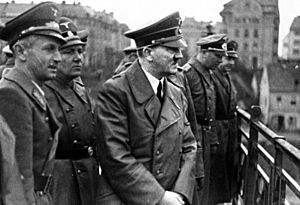Martin Bormann facts for kids
Quick facts for kids
Martin Bormann
Reichsleiter
|
|
|---|---|
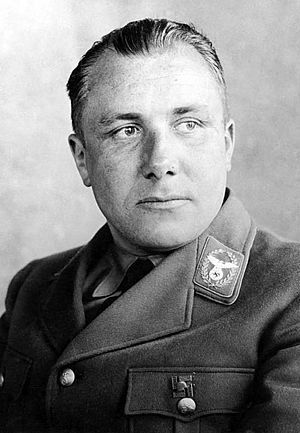
Bormann as Reichsleiter, 1934
|
|
| Party Minister of the Nazi Party | |
| In office 30 April 1945 – 2 May 1945 |
|
| Preceded by | Adolf Hitler (as Führer) |
| Succeeded by | Party abolished |
| Private Secretary to the Führer | |
| In office 12 April 1943 – 30 April 1945 |
|
| Führer | Adolf Hitler |
| Reichsminister without portfolio | |
| In office 29 May 1941 – 30 April 1945 |
|
| Chancellor | Adolf Hitler |
| Chief of the Nazi Party Chancellery | |
| In office 12 May 1941 – 2 May 1945 |
|
| Preceded by | Rudolf Hess (as Deputy Führer) |
| Succeeded by | Office abolished |
| Secretary to the Deputy Führer | |
| In office 1 July 1933 – 12 May 1941 |
|
| Deputy Führer | Rudolf Hess |
| Personal details | |
| Born |
Martin Ludwig Bormann
17 June 1900 Wegeleben, Prussia, German Empire |
| Died | 2 May 1945 (aged 44) Berlin, Nazi Germany |
| Political party | Nazi Party |
| Spouse |
Gerda Buch
(m. 1929) |
| Children | 10, including Martin Adolf Bormann |
| Parents | Theodor Bormann (father) Antonie Bernhardine Mennong (mother) |
| Relatives | Walter Buch (father-in-law) |
| Cabinet | Hitler cabinet |
| Signature |  |
| Nickname | Brown Eminence |
| Military service | |
| Branch/service | Imperial German Army Schutzstaffel |
| Years of service | 1918–1919 1927–1945 |
| Rank | SS-Obergruppenführer |
| Unit | 55th Field Artillery Regiment |
| Service number | 278,267 (SS) |
Martin Ludwig Bormann (June 17, 1900 – May 2, 1945) was a powerful official in the Nazi Party in Germany. He became very influential by controlling who could see and talk to Adolf Hitler, who was the leader. Bormann used his position as Hitler's private secretary to build a large system of control. He made sure he was involved in as many decisions as possible.
Bormann joined a group called the Freikorps in 1922. This was a paramilitary group, meaning it was organized like an army but was not part of the official military. He worked as a manager on a large farm at the time. He spent almost a year in prison because he was involved in a serious incident with his friend Rudolf Höss. Höss later became the commandant of the Auschwitz concentration camp. Bormann joined the Nazi Party in 1927 and the Schutzstaffel (SS) in 1937. He first worked in the party's insurance service. In July 1933, he moved to the office of Rudolf Hess, who was the Deputy Führer. There, Bormann became Hess's chief of staff.
Bormann became part of Hitler's closest group of advisors. He went everywhere with Hitler, giving him updates and summaries of events. He started working as Hitler's personal secretary on August 12, 1935. On May 10, 1941, Hess flew alone to Britain to try and make peace. After this, Bormann took over Hess's old duties. He was given the title of Head of the Parteikanzlei (Party Chancellery). He had the final say on who got government jobs. He also reviewed and approved new laws. By 1943, he was in charge of almost all matters inside Germany. Bormann was a strong supporter of the harsh treatment of certain groups, including Jews and Slavs, in areas Germany took over during World War II.
Bormann went back to the Führerbunker in Berlin with Hitler on January 16, 1945. This was because the Red Army was getting close to the city. After Hitler died by suicide, Bormann and others tried to escape Berlin on May 2. They wanted to avoid being captured by the Soviet forces. Bormann likely died by suicide on a bridge near Lehrter station. His body was buried nearby on May 8, 1945. However, it was not found and confirmed to be his until 1973. DNA tests in 1998 confirmed his identity again. Because Bormann was missing, he was tried in absentia (meaning he wasn't there) by the International Military Tribunal. This happened during the Nuremberg trials in 1945 and 1946. He was found guilty of serious wrongdoings and sentenced to death.
Contents
Early Life and Beginnings
Martin Bormann was born in Wegeleben, which was part of the Kingdom of Prussia in the German Empire. His father, Theodor Bormann, worked for the post office. His mother was Antonie Bernhardine Mennong. The family followed the Lutheran faith. Martin had two older half-siblings from his father's first marriage. His mother had three sons, but one died as a baby. Martin and his brother Albert (1902–89) grew up. Martin's father died when he was only three years old. His mother remarried soon after.
Bormann started studying at an agricultural high school. But his studies were stopped when he joined the 55th Field Artillery Regiment in June 1918. This was during the last days of World War I. He never fought in battles but served in a military base until February 1919. After working briefly in a cattle feed mill, Bormann became a manager on a large farm in Mecklenburg.
Soon after starting this job, Bormann joined a group of landowners who held strong anti-Jewish views. During a time of very high inflation in Germany, money became almost worthless. But food stored on farms became very valuable. Many farms, including Bormann's, had Freikorps units stationed there. These units guarded the crops from being stolen. Bormann joined a Freikorps group led by Gerhard Roßbach in 1922. He worked as a section leader and treasurer for this group.
On March 17, 1924, Bormann was sentenced to a year in prison. He was involved in a serious incident with his friend Rudolf Höss. They believed the victim had told French authorities that another Freikorps member was doing sabotage operations. Bormann was released from prison in February 1925. He then joined the Frontbann. This was a short-lived Nazi Party group created after the Sturmabteilung (SA) was banned. Bormann went back to his job in Mecklenburg and stayed there until May 1926. Then he moved in with his mother in Oberweimar.
Joining the Nazi Party
In 1927, Bormann officially joined the Nazi Party (NSDAP). His membership number was 60,508. He also joined the Schutzstaffel (SS) on January 1, 1937. By a special order from Heinrich Himmler in 1938, Bormann was given SS number 555. This showed he was an "Old Fighter" who had been with the party for a long time.
Early Roles in the Party
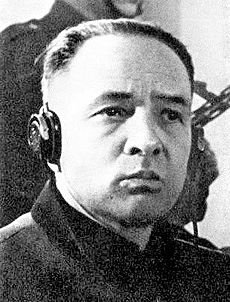
Bormann started working for Der Nationalsozialist, a weekly newspaper run by a Nazi Party member. After joining the Nazi Party in 1927, Bormann became a regional press officer. However, he wasn't good at public speaking, so this job didn't suit him. He soon used his organizing skills as a business manager for the Gau (region). In October 1928, he moved to Munich. There, he worked in the SA insurance office.
At first, the Nazi Party used regular insurance companies to cover members who were hurt or killed in fights. But insurance companies didn't want to pay for such activities. So, in 1930, Bormann created the Hilfskasse der NSDAP (Nazi Party Auxiliary Fund). This was a fund directly managed by the party. Every party member had to pay into it. They could receive money if they were injured while doing party work. Bormann alone decided who received payments from this fund. He started to be seen as good with money. Many party members felt they owed him a favor after getting help from the fund.
The fund also helped the Nazi Party when it was low on money. After the Nazi Party won many seats in the 1930 German federal election, more people joined the party. By 1932, the fund was collecting 3 million Reichsmarks per year. Bormann also worked for the SA from 1928 to 1930. While there, he founded the National Socialist Automobile Corps. This group helped organize cars donated by party members. Later, it also trained members in car skills.
Rising to Power: Reichsleiter and Party Chancellery Head
After the Nazi Party took power in January 1933, the relief fund changed. It started providing general accident and property insurance. So, Bormann left its management. He asked for a transfer and became chief of staff in Rudolf Hess's office on July 1, 1933. Hess was the Deputy Führer. Bormann also worked as Hess's personal secretary until May 12, 1941. Hess's department handled disagreements within the party. It also connected the party and the government on policy and laws. Bormann used his position to create a large system of control. He made sure he was involved in as many decisions as possible.
On October 10, 1933, Hitler named Bormann Reichsleiter (national leader). This was the second-highest political rank in the Nazi Party. In November, he became a member of the Reichstag (the German parliament). By June 1934, Bormann was getting closer to Hitler's inner circle. He went everywhere with Hitler, giving him updates and summaries.
In 1935, Bormann was put in charge of renovating the Berghof. This was Hitler's property in Obersalzberg. Hitler had bought the property, which he had been renting as a vacation home. After becoming chancellor, Hitler planned to expand the main house. Bormann was put in charge of the construction. Bormann ordered the building of barracks for SS guards, roads, garages, a guesthouse, and staff housing. Bormann bought nearby farms in his own name. This made the entire complex cover 10 square kilometers (3.9 sq mi). Other important Nazi officials, like Hermann Göring and Albert Speer, also built houses there. Bormann also ordered the building of the Kehlsteinhaus (Eagle's Nest). This was a tea house high above the Berghof. It was a gift for Hitler's 50th birthday in 1939. Hitler rarely used it, but Bormann liked to show it off to guests.
When Hitler was at the Berghof, Bormann was always there. He acted as Hitler's personal secretary. In this role, he started to control who could get information to Hitler and who could see him. During this time, Hitler gave Bormann control of his personal money. Hitler's income came from his salary as chancellor and president. It also came from royalties from his book Mein Kampf and from his image on postage stamps. Bormann set up the Adolf Hitler Fund of German Trade and Industry. This fund collected money from German business owners for Hitler. Some of this money went to other party leaders, but Bormann kept most of it for Hitler's personal use. Bormann and others wrote down Hitler's thoughts from dinners and late-night talks. These notes were published after the war as Hitler's Table Talk.
The office of the Deputy Führer had the final say on government job appointments. Bormann reviewed the files and made these decisions. This power overlapped with the duties of the Minister of the Interior, Wilhelm Frick. This was an example of how responsibilities often overlapped in the Nazi government. Bormann traveled everywhere with Hitler. This included trips to Austria in 1938 after the Anschluss (Austria joining Nazi Germany). He also went to the Sudetenland after the Munich Agreement later that year. Bormann was also in charge of organizing the 1938 Nuremberg Rally, a big annual party event.
Hitler often made his top party members compete against each other. He also made the Nazi Party compete against the government workers. This created distrust and rivalry among his staff. It helped him keep and increase his own power. Hitler usually didn't give written orders. Instead, he told them what to do verbally or had Bormann pass on the messages. If someone lost Bormann's favor, they lost access to Hitler. Bormann was very skilled at political infighting. He used his ability to control access to Hitler to limit the power of other high-ranking officials. Many of them became his enemies. This constant struggle for power and Hitler's favor was a key part of how the Third Reich worked.
As World War II went on, Hitler focused only on war and foreign affairs. Hess, who wasn't directly involved in these things, became less important to Hitler. Bormann had successfully taken over many of Hess's duties and his place by Hitler's side. Hess was worried that Germany would have to fight a war on two fronts. This was because plans were being made for Operation Barbarossa, the invasion of the Soviet Union. Hess flew alone to Britain on May 10, 1941, to try and negotiate peace. He was arrested when he arrived and stayed a British prisoner for the rest of the war. He later received a life sentence for serious wrongdoings at the Nuremberg trials in 1946.
Speer later said Hitler called Hess's departure one of the worst things that ever happened to him. Hitler saw it as a personal betrayal. Hitler ordered that Hess be shot if he returned to Germany. He also ended the position of Deputy Führer on May 12, 1941. He gave Hess's old duties to Bormann, with the title of Head of the Parteikanzlei (Party Chancellery). In this role, Bormann was responsible for all Nazi Party appointments. He only answered to Hitler. By a special order on May 29, Bormann also took Hess's place on the six-member Council of Ministers for Defense of the Reich. This council acted like a war cabinet. He was also given a cabinet rank similar to a Reichsminister without a specific department. People started calling him the "Brown Eminence," but never to his face.
Bormann's power grew a lot during the war. By early 1943, the war caused a shortage of workers for the government. Hitler created a three-person committee to try and centralize control of the war economy. The committee members were Hans Lammers (head of the Reich Chancellery), Field Marshal Wilhelm Keitel (chief of the Oberkommando der Wehrmacht), and Bormann (who controlled the Party). This committee was supposed to suggest ideas independently. Hitler kept most final decisions for himself. The committee met eleven times between January and August 1943. However, they faced resistance from Hitler's cabinet ministers. These ministers had strong areas of influence and were not on the committee. They saw the committee as a threat to their power. So, Joseph Goebbels, Göring, and Speer worked together to stop it. As a result, nothing changed, and the committee became unimportant.
Role in the Church Struggle
The Nazi Party's program said it would allow Christian religions with certain conditions. A treaty with the Vatican was signed in 1933, promising religious freedom for Catholics. However, Hitler believed that Christianity and Nazism could not exist together. Bormann strongly agreed. He publicly said in 1941 that "National Socialism and Christianity are irreconcilable." For political reasons, Hitler planned to get rid of Christian churches after the war. But his repeated negative comments about the church showed his staff that attacking the church would be allowed and even encouraged.
Bormann was a strong supporter of the ongoing harsh treatment of Christian churches. In February 1937, he ordered that church leaders should not be allowed to join the Nazi Party. The next year, he ruled that any church leaders holding party jobs should be fired. Also, any party member thinking of becoming a church leader had to give up their party membership. Bormann tried to close down religious study departments at universities, but he failed. However, he was able to reduce religious lessons in public schools to two hours a week. He also ordered that crucifixes be removed from classrooms. Speer wrote in his memories that Bormann told him that churches would not be given building sites in the plans for rebuilding Berlin.
As part of the campaign against the Catholic Church, hundreds of monasteries in Germany and Austria were taken over by the Gestapo. The people living there were forced out. In 1941, the Catholic Bishop of Münster, Clemens August Graf von Galen, spoke out against this treatment. Bormann and others wanted Galen to be hanged. But Hitler and Goebbels decided that killing Galen would only make him a martyr and cause more trouble. Hitler decided to deal with the issue after the war ended.
Historian Richard Overy described Bormann as someone who did not believe in God.
Hitler's Personal Secretary
Hitler became very focused on military matters and spent most of his time at his military headquarters. He relied more and more on Bormann to handle the country's domestic policies. On April 12, 1943, Hitler officially named Bormann as his Personal Secretary. By this time, Bormann already controlled almost all matters inside Germany. This new appointment gave him the power to act officially in any situation.
Bormann always pushed for very harsh and extreme measures. This included how Jews, people in the conquered eastern lands, and prisoners of war were treated. He signed a law on May 31, 1941, that extended the 1935 Nuremberg Laws to the newly taken eastern territories. Later, he signed a law on October 9, 1942. This law stated that the "Final Solution" for Jews in Germany could no longer be solved by moving them. Instead, it would be solved by "ruthless force in the special camps of the East." This meant extermination in Nazi death camps. Another law, signed by Bormann on July 1, 1943, gave Adolf Eichmann complete power over Jews. They were now only under the control of the Gestapo. Historians estimate that millions of Jews were killed by the Nazi regime during The Holocaust.
Bormann knew Hitler saw the Slavs as inferior. So, Bormann was against bringing German criminal law into the conquered eastern territories. He pushed for and eventually got a strict, separate law system. This system used martial law for Polish and Jewish people in these areas. The "Edict on Criminal Law Practices against Poles and Jews in the Incorporated Eastern Territories," issued on December 4, 1941, allowed severe physical punishment and death sentences for even small offenses.
Bormann supported the very strict approach of Erich Koch, who was in charge of Ukraine. Koch treated Slavic people very brutally. Alfred Rosenberg, who was head of the Reich Ministry for the Occupied Eastern Territories, wanted a more moderate policy. After visiting farms in Ukraine, Bormann was worried about the health of the people. He feared they could become a danger to the government.
Bormann and Himmler were both responsible for the Volkssturm (people's militia). This group drafted all remaining able-bodied men aged 16 to 60 into a last-effort militia. It was formed on October 18, 1944. These men were poorly equipped and trained. They were sent to fight on the eastern front. Almost 175,000 of them were killed, and they had no real impact on the Soviet advance.
Final Days in Berlin
Hitler moved his headquarters to the Führerbunker ("Leader's bunker") in Berlin on January 16, 1945. He stayed there with Bormann, his secretary Else Krüger, and others until the end of April. The Führerbunker was located under the Reich Chancellery garden in the city center. The Battle of Berlin, the last major Soviet attack of the war, began on April 16, 1945. By April 19, the Red Army started to surround the city. On April 20, his 56th birthday, Hitler went outside for the last time. In the ruined garden, he gave awards to boy soldiers of the Hitler Youth. That afternoon, Berlin was bombed by Soviet artillery for the first time. On April 23, Albert Bormann left the bunker complex and flew away. Hitler had ordered him and several others to leave Berlin.
In the early morning hours of April 29, 1945, Wilhelm Burgdorf, Goebbels, Hans Krebs, and Bormann witnessed and signed Hitler's last will and testament. In the will, Hitler called Bormann "my most faithful Party comrade." He also named him the person to carry out his will. That same night, Hitler married Eva Braun in a civil ceremony.
As Soviet forces continued to fight their way into the center of Berlin, Hitler and Braun died by suicide on the afternoon of April 30. According to Hitler's last wishes, Bormann was named Party Minister. This officially confirmed him as having the top position in the Party. Grand Admiral Karl Dönitz was appointed as the new Reichspräsident (President of Germany). Goebbels became the head of government and Chancellor of Germany. Hitler did not name anyone to succeed him as Führer or as leader of the Nazi Party.
On May 2, the Battle in Berlin ended. General der Artillerie Helmuth Weidling, the commander of Berlin's defense, surrendered the city to General Vasily Chuikov.
Death and Discovery of Remains
Axmann's Account of Bormann's Death
Around 11:00 pm on May 1, Bormann left the Führerbunker. He was with SS doctor Ludwig Stumpfegger, Hitler Youth leader Artur Axmann, and Hitler's pilot Hans Baur. They were part of a group trying to escape the Soviet forces surrounding them. Bormann carried a copy of Hitler's last will. The group left the bunker and walked through a U-Bahn subway tunnel to the Friedrichstraße station. There, they came to the surface.
Several people in the group tried to cross the Spree river at the Weidendammer Bridge. They hid behind a Tiger tank. The tank was hit by an anti-tank round, and Bormann and Stumpfegger fell to the ground. Bormann, Stumpfegger, and others finally crossed the river on their third try. Bormann, Stumpfegger, and Axmann walked along the railway tracks to Lehrter station. There, Axmann decided to leave the others and go in a different direction. When he met a Red Army patrol, Axmann turned back. He saw two bodies, which he later said were Bormann and Stumpfegger, on a bridge near the railway yard. He didn't have time to check closely, so he didn't know how they died. Since the Soviets never said they found Bormann's body, his fate was unknown for many years.
Tried in His Absence at Nuremberg
After the war, there were many confusing reports about where Bormann was. People claimed to have seen him in Argentina, Spain, and other places. Bormann's wife was watched in case he tried to contact her. Jakob Glas, Bormann's longtime driver, insisted he saw Bormann in Munich in July 1946. In case Bormann was still alive, public notices about the upcoming Nuremberg trials were put in newspapers and on the radio in late 1945. This was to let him know about the legal proceedings against him.
The trial began on November 20, 1945. Because there was no proof that Bormann had died, the International Military Tribunal tried him in absentia. This was allowed by their rules. He was accused of three things: planning an aggressive war, war crimes, and crimes against humanity. His defense lawyer argued that the court could not convict Bormann because he was already dead. But this argument was not successful. Bormann was found guilty of war crimes and crimes against humanity. He was found not guilty of planning an aggressive war. On October 15, 1946, he was sentenced to death by hanging. The court said that if he were found alive later, any new facts could be used to reduce or overturn the sentence.
Finding His Remains
Over the years, several groups, including the CIA and the West German government, tried to find Bormann without success. In 1964, the West German government offered a reward for information leading to Bormann's capture. People reported seeing him all over the world. Nazi hunter Simon Wiesenthal believed Bormann was living in South America. The West German government announced that their search for Bormann was over in 1971.
In 1963, a retired postal worker named Albert Krumnow told police that around May 8, 1945, the Soviets had ordered him and his co-workers to bury two bodies. They were found near a railway bridge near Lehrter station. One body wore a Wehrmacht uniform, and the other only underwear. Krumnow's colleague found an SS doctor's paybook on the second body. It identified him as Ludwig Stumpfegger. He gave the paybook to his boss, who gave it to the Soviets. They then destroyed it.
Excavations on July 20–21, 1965, at the spot Axmann and Krumnow described, did not find the bodies. However, on December 7, 1972, construction workers found human remains near Lehrter station in West Berlin. It was only 12 meters (39 ft) from where Krumnow said he had buried them. Dental records, remembered from 1945, identified one skeleton as Bormann's. Damage to the collarbone matched injuries Bormann's sons said he got in a riding accident in 1939. Experts determined that the skeleton's size and skull shape matched Bormann's. Facial reconstruction was done in early 1973 on both skulls to confirm who they were. Soon after, the West German government declared Bormann dead. His family was not allowed to cremate the body. This was in case more tests were needed later.
The remains were finally confirmed to be Bormann's in 1998. German authorities ordered genetic testing on skull fragments. Tests using DNA from one of his relatives confirmed the skull belonged to Bormann. Bormann's remains were cremated, and his ashes were scattered over the Baltic Sea on August 16, 1999.
Personal Life
On September 2, 1929, Bormann married 19-year-old Gerda Buch (October 23, 1909 – March 23, 1946). Her father, Major Walter Buch, was a chairman of a committee that settled disputes within the Nazi Party. Hitler often visited the Buch house, and that's where Bormann met him. Hess and Hitler were witnesses at the wedding. Bormann also had several mistresses, including actress Manja Behrens.
Martin and Gerda Bormann had ten children:
- Martin Adolf Bormann (April 14, 1930 – March 11, 2013); called Krönzi (short for "crown prince"); born "Adolf Martin Bormann", named after Hitler, his godfather.
- Ilse Bormann (July 9, 1931 – 1958); named after her godmother, Ilse Hess. Later called Eike.
- Ehrengard Bormann (July 9, 1931 – 1932); twin sister of Ilse.
- Irmgard Bormann (born July 25, 1933).
- Rudolf Gerhard Bormann (born August 31, 1934; named after his godfather Rudolf Hess). His name was changed to Helmut.
- Heinrich Hugo Bormann (born June 13, 1936; named after his godfather Heinrich Himmler).
- Eva Ute Bormann (born May 4, 1938).
- Gerda Bormann (born August 4, 1940).
- Fritz Hartmut Bormann (born April 3, 1942).
- Volker Bormann (September 18, 1943 – 1946).
Gerda Bormann and the children fled Obersalzberg for Italy on April 25, 1945, after an Allied air attack. She died of cancer on March 23, 1946, in Merano, Italy. Bormann's children survived the war and were cared for in foster homes. His oldest son, Martin, became a Roman Catholic priest and worked in Africa as a missionary. He later left the priesthood and married.
Images for kids
See also
 In Spanish: Martin Bormann para niños
In Spanish: Martin Bormann para niños


